
myCBSEguide App
Download the app to get CBSE Sample Papers 2025-26, NCERT Solutions (Revised), Most Important Questions, Previous Year Question Bank, Mock Tests, and Detailed Notes.
Install NowCBSE class 10 Science Chapter 6 Life Processes notes in PDF are available for free download in myCBSEguide mobile app. The best app for CBSE students now provides Life Processes class 10 Notes latest chapter wise notes for quick preparation of CBSE board exams and school based annual examinations. Class 10 Science notes on Chapter 6 Life Processes are also available for download in CBSE Guide website.
CBSE Guide Life Processes class 10 Notes
CBSE guide notes are the comprehensive notes which covers the latest syllabus of CBSE and NCERT. It includes all the topics given in NCERT class 10 Science text book. Users can download CBSE guide quick revision notes from myCBSEguide mobile app and my CBSE guide website.
10 Science notes Chapter 6 Life Processes
Download CBSE class 10th revision notes for Chapter 6 Life Processes in PDF format for free. Download revision notes for Life Processes class 10 Notes and score high in exams. These are the Life Processes class 10 Notes prepared by team of expert teachers. The revision notes help you revise the whole chapter in minutes. Revising notes in exam days is on of the best tips recommended by teachers during exam days.
Revision Notes for Class 6 Science Download as PDF
CBSE Class 10 Science Revision Notes Chapter 6 Life Processes
- All living things perform certain life processes like growth, excretion, respiration, circulation etc.
- The basic functions performed by living organisms for their survival and body maintenance are called life process.
Basic life processes are : Nutrition, Respiration, Transportation, Excretion etc.
Life Processes require energy which is provided by nutrition.
Modes of Nutrition
- Autotrophic :-Kind of nutrition in which organisms can synthesize their own food Eg. Green Plants
- Heterotrophic:- Kind of nutrition of which organisms do not possess the ability to synthesize their own food. They depend on autotrophs for their food supply directly or indirectly. Eg. Animals, Fungi
Autotrophic Nutrition
- Autotrophs : The organisms which can make their own food are called autotrophs (green plants).
- Photosynthesis : The process by which green plants make their own food with the help of CO and H O in the presence of chlorophyll and sunlight is also called photosynthesis.
- Raw Materials for Photosynthesis :
- Site of Photosynthesis : Chloroplast in the leaf. Chloroplast contain chlorophyll. (green pigment).

- Main Events of Photosynthesis

Absorption of Sunlight energy by chlorophyll
to carbohydrates.
- Stomata : Tiny pores present on the surface of the leaves.
- Functions of Stomata
- (i) Exchange of gases
- (ii) Loses large amount of water [water vapour] during transpiration and helps in up flow of water
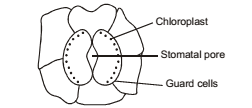
Chloroplast contains the green pigment chlorophyll which has a pivotal role in photosynthesis.
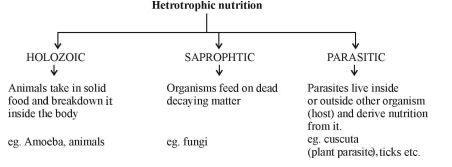
- Nutrition in Animals

- Nutrition in Amoeba
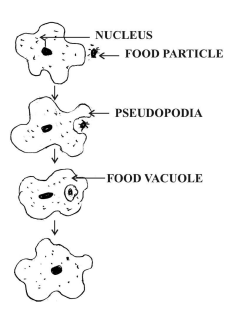
Amoeba has a holozoic nutrition. Thus, solid food particles are ingested which react with enzymes and are digested. It is an omnivore.
(i) Amoeba move with the help of pseudopodia (extension of cell membrane)
(ii) Food vacule is formed
(iii) Undigested food is thrown out.
- Nutrition in Human Beings : The human digestive system comprises of alimentary canal and associated digestive glands.
HUMAN DIGESTIVE SYSTEM
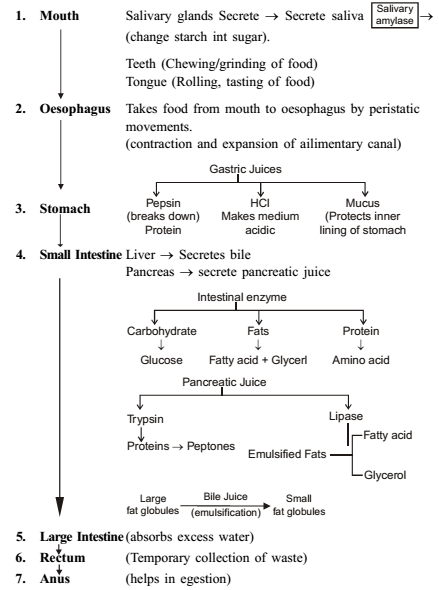
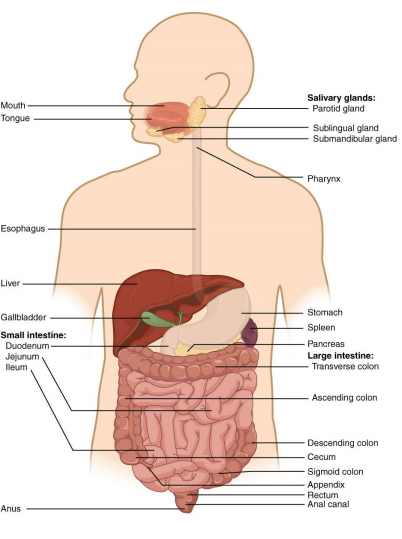
HUMAN DIGESTIVE SYSTEM: As shown in the flow chart, digestion begins from th mouth.In the mouth it is broken down by salivary amylase. The food moves to the stomach through the oesophagus which performs persistatic movement. Enzymes and various digestion juices from liver,gall bladder and pancreas act on the chunks from the stomach in the small intestine. In the large intestine , the remaining nutrients are absorbed and the leftover is removed from the body through the rectum and anus.
Respiration
It is a process in living organisms involving the production of energy, typically with the intake of oxygen and the release of carbon dioxide from the oxidation of complex organic substances.
(i) Gaseous exchange : Intake of oxygen from the atmosphere and release of carbondioxide.
(ii) Breakdown of simple food in order to release energy inside the CellularRespiration
- Breakdown of Glucose by various pathways
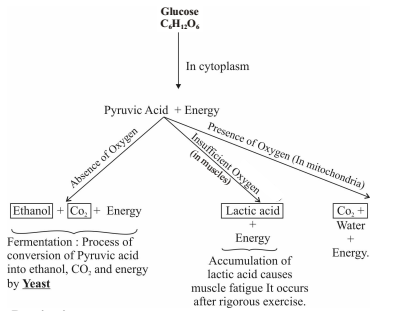
- Respiration
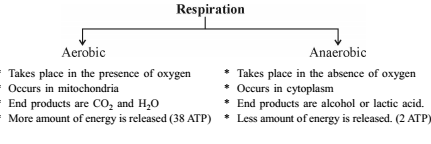
- Human Respiratory System : Passage of air through the respiratory system.
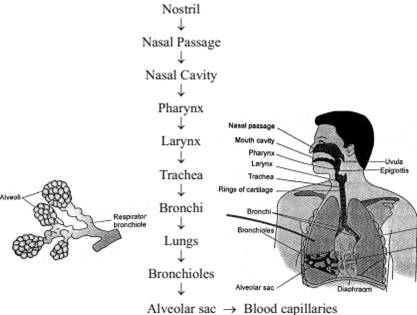
- Mechanism of Breathing
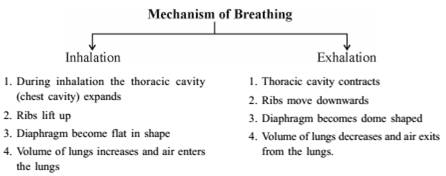
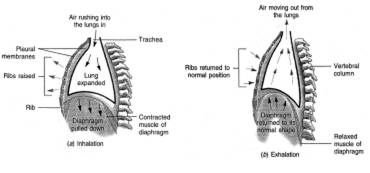
- Exchange of Gases between alveolus, blood and tissues.
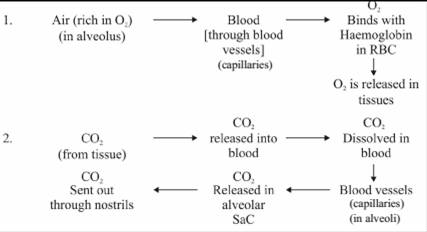
- Terrestrial Organism – use atmospheric oxygen for respiration
- Aquatic Organisms – use oxygen dissolved in water.
- Respiration in Plants : Respiration in plants is simpler than the respiration in animals. Gaseous exchange occur through
1. Stomata in leaves
2. Lenticels in stems
3. General surface of the roots.
Transportation
- Human beings like other multicellular organism need regular supply of food, oxygen etc., This function is performed by circulatory system or Transport system.
- The circulatory system in human beings consists of :
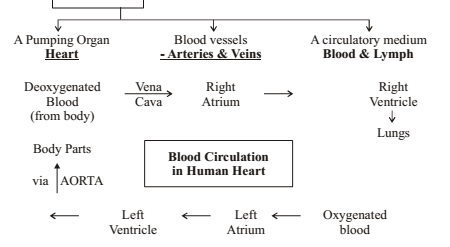
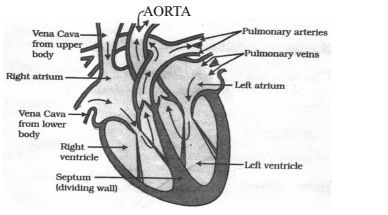
Section view of the Human Heart
- Double Circulation : Blood travels twice through the heart in one complete cycle of the body.
- Pulmonary circulation : blood moves from the heart to the hugs and back the heart.
- Systemic circulation :blood moves from the heart to rest of the body and back to the heart.
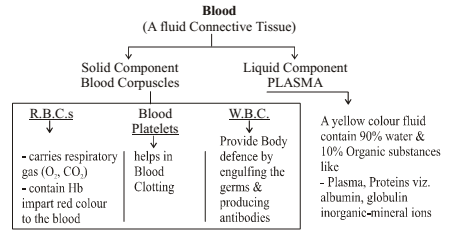
- Lymph – a yellowish fluid that escapes from the blood capillaries into the intercellular spaces. Lymph flows from the tissues to the heart assisting in transportation and destroying germs.
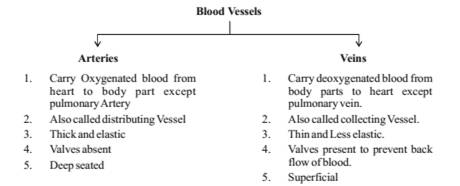
- Transportation in Plants : There are two main conducting tissues in a plant.
(a) Xylem (b) Phloem.

- Transpiration is the process by which plants lose water in the form of vapours.
- Role of Transpiration
1. Absorption and upward movement of water and minerals by creating PULL.
2. Helps in temperature regulation in Plant. - Translocation : Transport of food from leaves (food factory) to different part of the plant is called Translocation.
- Excretion in human beings : The process of the removal of the harmful metabolic wastes from the body is called excretion. Excretory system of human beings includes :
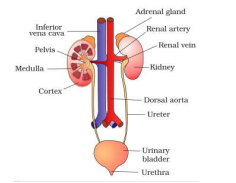
- A pair of kidney
- A Urinary Bladder
- A pair of Ureter
- A Urethera
- Process of Excretion
Renal artery bring in blood containing waste substances to the kidneys.
Kidney filters blood.
Urine produced in the kidneys passes through the ureters into the urinary bladder where it is stored until it is released through the urethera. - Function of Kidney : It is remove waste product from the blood i.e., urea which is produced in the liver.
- Nephron : Each kidney has a large number of filtration units called nephrons.
Nephron is the structural and functional unit of Kidney.
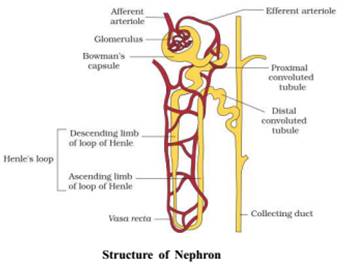
- Mechanism of Urine Formation : The Urine formation involves three steps:
- Glomerular Filtration : Blood is filtered from the glomerulus into Bowman Capsule of the nephron. This filtrate passes through the tubules of the nephron.
- Tubular re-absorption : Now, useful substances from the filtrate Like , glucose, amino acids etc. are reabsorbed by the capillaries surrounding the nephron into the blood.
- Secretion : Urea, extra water and salts are secreted into the tubule which open up into the collecting duct & then into the ureter.
- Haemodialysis: The process of purifying blood by an artificial kidney. It is meant for Kidney failure patient.
Excretion in Plants
1. Oxygen released during photosynthesis.
2. by transpiration
3. Wastes may be stored in leaves, bark etc. which fall off from the plant.
4. Waste products stored as gums, resin in old Xylem
5. Plants excrete some waste into the soil around them.
Life Processes class 10 Notes
- CBSE Revision notes (PDF Download) Free
- CBSE Revision notes for Class 10 Science PDF
- Revision notes Class 10 Science – CBSE
- CBSE Revisions notes and Key Points Class 10 Science
- Summary of the NCERT books all chapters in Science class 10
- Short notes for CBSE class 10th Science
- Key notes and chapter summary of Science class 10
- Quick revision notes for CBSE board exams
CBSE Class-10 Revision Notes and Key Points
Life Processes class 10 Notes. CBSE quick revision note for Class-10 Science, Chemistry, Maths, Biology and other subject are very helpful to revise the whole syllabus during exam days. The revision notes covers all important formulas and concepts given in the chapter. Even if you wish to have an overview of a chapter, quick revision notes are here to do if for you. These notes will certainly save your time during stressful exam days.
To download Life Processes class 10 Notes, sample paper for class 10 Mathematics, Social Science, Science, English Communicative; do check myCBSEguide app or website. myCBSEguide provides sample papers with solution, test papers for chapter-wise practice, NCERT solutions, NCERT Exemplar solutions, quick revision notes for ready reference, CBSE guess papers and CBSE important question papers. Sample Paper all are made available through the best app for CBSE students and myCBSEguide website.
- Chemical Reactions and Equations class 10 Notes Science
- Acids Bases and Salts class 10 Notes Science
- Metals and Non-metals class 10 Notes Science
- Carbon and its Compounds class 10 Notes Science
- Periodic Classification of Elements class 10 Notes Science
- Control and Coordination class 10 Notes Science
- How do Organisms Reproduce class 10 Notes Science
- Heredity and Evolution class 10 Notes Science
- Light Reflection and Refraction class 10 Notes Science
- Human Eye and Colourful World class 10 Notes Science
- Electricity class 10 Notes Science
- Magnetic Effects of Electric Current class 10 Notes Science
- Sources of Energy Current class 10 Notes Science
- Our Environment class 10 Notes Science
- Management of Natural Resources class 10 Notes Science

Test Generator
Create question paper PDF and online tests with your own name & logo in minutes.
Create Now
Learn8 App
Practice unlimited questions for Entrance tests & government job exams at ₹99 only
Install Now